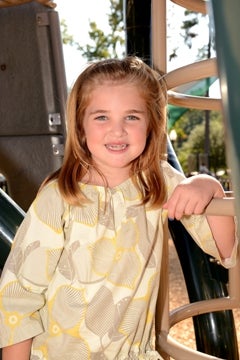Severe Aplastic Anemia
As residents of the Birmingham suburb of Vestavia Hills, Jennifer and Blaine House were familiar with Children’s of Alabama and its mission of caring for kids. Blaine had even volunteered for more than a decade with the Annual Pig Iron BBQ Challenge, which benefits Children’s Harbor Family Center. But three years ago, when their oldest daughter, Maisie, was diagnosed with severe aplastic anemia – an often life-threatening disorder that annually affects just two to six people per million – everything changed. As they drove into the parking deck on Maisie’s first day of treatment, Blaine told his wife, “Now we’re that family that we’ve been supporting.” When Maisie was four years old, she began to experience some unusual bruising. “We took her to the doctor, and her blood work came back very abnormal,” Jennifer says. “I remember the pediatrician telling us, ‘Well, it’s either leukemia or severe aplastic anemia. Either way you need to be seen right away at the Alabama Center for Childhood Cancer and Blood Disorders at Children’s.’” “When she came to us, Maisie was very anemic and had very low blood counts, and her immune system was quite suppressed” says Fred Goldman, MD, director of the Lowder Blood and Marrow Transplant Program at Children’s. “Maisie’s best treatment option at that time was a bone marrow or stem cell transplant. Finding a donor for transplant was the first order of business. “Remarkably her parents had saved Maisie’s umbilical cord blood – we had our stem cell donor right there. And although transplanting with one’s own cord blood for aplastic anemia had never been done before, we felt this would offer her the best chance for cure with minimal side effects.” In addition to outpatient visits before and after her stem cell transplant, Maisie was hospitalized for about five weeks at Children’s, where she received chemotherapy and antibiotics before receiving her cord blood transplant. The transplant was a success, and today she is an active, artistic second grader. Dr. Goldman predicts a bright future not only for Maisie, but also for other children with cancer, immune deficiencies or blood disorders who may one day benefit from stem cell therapies. “It’s very rewarding to see such a wonderful outcome – a beautiful young girl who dances, plays soccer and enjoys life to the fullest. What we did for her would not have been possible had it not been for research done on stem cells the past several years. “Work being done at the Stem Cell Institute at UAB is cutting edge with some of the best scientists in the world – in fact, many researchers are working on a way to generate bone marrow from one’s own skin cells. If successful, this could completely change the way we do transplants. We hope someday to use this technology to cure not only cancers and aplastic anemia, but also other medical conditions by taking advantage of the healing properties of stem cells.” Blaine says his family is thankful to have such an excellent resource located so close to home. “We appreciate having Dr. Goldman on staff, as well as nurses who care and treat every patient like their own child. “There’s a mutual respect among the staff and the families at Children’s that says, ‘Hey, we’re all in this together and though we’re here for different reasons, we’re pulling for each other. We’re pulling for your child.’ This gave us peace that we were in absolutely the right place.”







